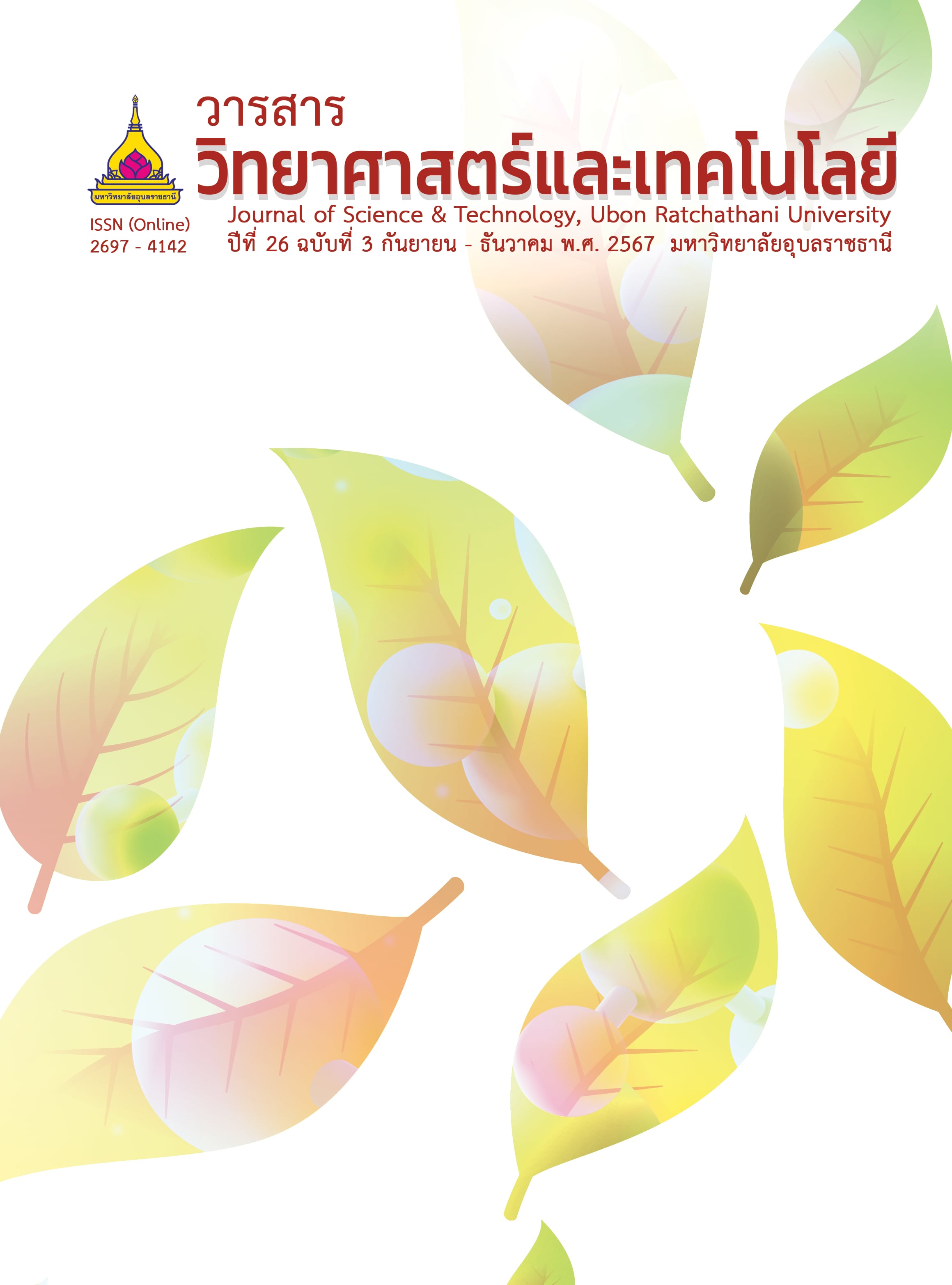การประเมินคุณภาพทางจุลชีววิทยาของน้ำในลำห้วยหลวง ตำบลสามพร้าว อำเภอเมือง จังหวัดอุดรธานี
Main Article Content
บทคัดย่อ
งานวิจัยนี้มีวัตถุประสงค์เพื่อประเมินคุณภาพทางจุลชีววิทยาของน้ำในลำห้วยหลวง ตำบลสามพร้าว อำเภอเมือง จังหวัดอุดรธานี ตั้งแต่เดือนมกราคมถึงธันวาคม 2565 โดยสุ่มเก็บตัวอย่างน้ำเดือนละ 1 ครั้งจากจุดเก็บตัวอย่าง 4 แห่ง ในลำห้วยหลวง บริเวณพื้นที่ชุมชนสามพร้าวและชุมชนหนองคอนแสน ตำบลสามพร้าว อำเภอเมือง จังหวัดอุดรธานี รวมจำนวนตัวอย่างน้ำทั้งสิ้น 48 ตัวอย่าง การตรวจวัดปริมาณแบคทีเรียโคลิฟอร์ม (TCB) และฟีคัลโคลิฟอร์ม (FCB) ในน้ำตัวอย่างใช้วิธี Multiple-tube fermentation technique และรายงานค่า TCB และ FCB ในหน่วย Most Probable Number index ต่อน้ำ 100 มิลลิลิตร (MPN/100 mL) ผลการวิเคราะห์ TCB และ FCB ในน้ำตัวอย่างที่เก็บจากจุดเก็บตัวอย่างทั้ง 4 แห่ง พบว่า มีค่าเฉลี่ยระหว่าง 26,867-137,833 MPN/100 mL และ 5,820-19,454 MPN/100 mL ตามลำดับ ซึ่งไม่ผ่านเกณฑ์มาตรฐานคุณภาพของน้ำผิวดินประเภทที่ 3 ตามประกาศของกรมควบคุมมลพิษ กระทรวงทรัพยากรธรรมชาติและสิ่งแวดล้อม (TCB<20,000; FCB<4,000 MPN/100 mL) เมื่อนำ TCB และ FCB ในน้ำตัวอย่างของแต่ละฤดูกาลมาเปรียบเทียบกัน พบว่า ค่าเฉลี่ยของ TCB (105,813 MPN/100 mL) และ FCB (19,472 MPN/100 mL) ในฤดูร้อน (กุมภาพันธ์-พฤษภาคม) มีค่าสูงสุด รองลงมาคือค่าเฉลี่ยของ TCB (81,806 MPN/100 mL) และ FCB (12,340 MPN/100 mL) ในฤดูหนาว (ตุลาคม-มกราคม) ส่วนค่าเฉลี่ยของ TCB (45,088 MPN/100 mL) และ FCB (6,525 MPN/100 mL) ในฤดูฝน (มิถุนายน-กันยายน) มีค่าต่ำสุด นอกจากนี้ เมื่อเปรียบเทียบคุณภาพของน้ำในลำห้วยหลวงของปี 2565 กับปี 2564 พบว่าค่าเฉลี่ยของ TCB และ FCB ในปี 2565 มีค่าสูงกว่าตลอดทั้งปี จากผลการศึกษานี้ ทำให้ทราบว่าน้ำในลำห้วยหลวงมีแบคทีเรียปนเปื้อน ซึ่งอาจส่งผลกระทบต่อสุขภาพของผู้ใช้น้ำเพื่อการอุปโภคบริโภคได้ ดังนั้นจึงควรมีการบำบัดน้ำเสียและการจัดการน้ำเสียก่อนปล่อยจากชุมชนลงสู่แหล่งน้ำสาธารณะเพื่อลดปัญหามลพิษทางน้ำและการปนเปื้อนเชื้อก่อโรค
Article Details

อนุญาตภายใต้เงื่อนไข Creative Commons Attribution-NonCommercial-NoDerivatives 4.0 International License.
บทความที่ได้รับการตีพิมพ์เป็นลิขสิทธิ์ของ วารสารวิทยาศาสตร์และเทคโนโลยี มหาวิทยาลัยอุบลราชธานี
ข้อความที่ปรากฏในบทความแต่ละเรื่องในวารสารวิชาการเล่มนี้เป็นความคิดเห็นส่วนตัวของผู้เขียนแต่ละท่านไม่เกี่ยวข้องกับมหาวิทยาลัยอุบลราชธานี และคณาจารย์ท่านอื่นๆในมหาวิทยาลัยฯ แต่อย่างใด ความรับผิดชอบองค์ประกอบทั้งหมดของบทความแต่ละเรื่องเป็นของผู้เขียนแต่ละท่าน หากมีความผิดพลาดใดๆ ผู้เขียนแต่ละท่านจะรับผิดชอบบทความของตนเองแต่ผู้เดียว
เอกสารอ้างอิง
Thongsri, T., Petchkasem, S. and Muangkaew, K. 2014. An assessment of coliform and fecal coliform bacteria levels in surface water resources of Bangkok and vicinity area. Bulletin of Applied Sciences. 3(3): 59-67. (in Thai)
Homthong, S. and Nitirojpanya, K. 2021. Assessment of coliform bacteria, fecal coliform and Escherichia coli in drinking water from water dispensers at Education Building, Burapha University, Chonburi Province. The Golden Teak: Science and Technology Journal. 8(2): 1-12. (in Thai)
Nimrat, S. and Vuthiphandchai, V. 2017. Physical and microbiological qualities of clear and opaque bottled drinking water distributed in Ayutthaya Province. Journal of Science and Technology, Ubon Ratchathani University. 19(3): 193-207. (in Thai)
Nuengjui, M. and Chanpiwat, P. 2021. “Bacteria” water quality index biological water of Rayong River in the Eastern Special Economic Area. Environmental Journal. 25(2): 1-6. (in Thai)
Bootdee, K. and et al. 2022. Monitoring of surface water quality at Ubon Ratchathani University. The Journal of Industrial Technology. 18(3): 146-160. (in Thai)
Aram, S.A., Saalidong, B.M. and Lartey, P.O. 2021. Comparative assessment of the relationship between coliform bacteria and water geochemistry in surface and ground water systems. PLoS One. 16(9): e0257715.
Seo, M., Lee, H. and Kim, Y. 2019. Relationship between coliform bacteria and water quality factors at weir stations in the Nakdong River, South Korea. Water. 11(6): 1171.
Ky, N.M. and Lam, N.H. 2016. Analysis of changing trend of fecal coliform levels at lakes in Hue Citadel, Vietnam. Environment and Natural Resources Journal. 14(1): 1-7.
Zhang, X. and et al. 2020. Spatiotemporal variability and key influencing factors of river fecal coliform within a typical complex watershed. Water Research. 178: 115835.
Wongaree, M. 2019. Water quality assessment by using of water quality index for Mak Khaeng canal, Udon Thani Province, Thailand. EnvironmentAsia. 12(2): 96-104.
Some, S. and et al. 2021. Microbial pollution of water with special reference to coliform bacteria and their nexus with environment. Energy Nexus. 1: 100008.
Bigham, T. and et al. 2019. Microbial water quality: Voltammetric detection of coliforms based on riboflavin-ferrocyanide redox couples. Electrochemistry Communications. 101: 99-103.
Miloudi, S. 2019. Increasing and eliminating the (fecal coliforms, thermotolerant coliform and fecal streptococcus) bacteria by resin of the poly (para carboxy acid phenol-D-Glucose) to clean up waste water. Human Microbiome Journal. 11: 100053.
Sillberg, C.V., Kullavanijaya, P. and Chavalparit, O. 2021.Water quality classification by integration of attribute-realization and support vector machine for the Chao Phraya River. Journal of Ecological Engineering. 22(9): 70-86.
Pansuk, N., Vinitnantharat, S. and Pattanachan, P. 2019. Effect of season on water quality of extensive and intensive seabass culture ponds and associated canals. Veridian E-Journal, Science and Technology Silpakorn University. 6(6): 1-15. (in Thai)
Sittisorn, P. 2017. Assessment of water quality of Bang Pakong River using multivariate analysis. Burapha Science Journal. 22(2): 183-196. (in Thai)
Wangka-orm, C. and et al. 2023. Water quality analysis for agriculture: A case study of Nong Khon Saen community area, Udon Thani, Thailand. International Journal of Environmental Science and Development. 14(3): 185-189.
Monprapussorn, M. 2022. Land use change and ecosystem service variations in Huai Luang River Basin, Udon Thani Province, Thailand. In: Proceedings of the 2nd Applied Geography and Geoinformatics for Sustainable Development, 11 December 2022. Phuket, Thailand.


